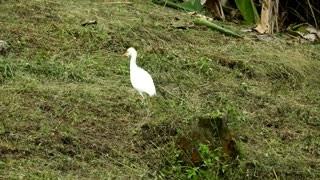An extremely close look at a dangerous back yard parasite
As spring weather arrives for most of North America, it brings the arrival of something very dangerous. The deer tick, also referred to as a black legged tick, is the main vector for a potentially fatal disease called Lyme disease. Although these ticks are active in winter and still pose a threat to people and animals alike, they are much more abundant in the spring and summer.
This magnified video lets you get a close look at the head and mouth of the deer tick , allowing you to see how they hold on to their prey with such tenacity. The tick burrows its head deep into the flesh of its host and will remain attached to feed for 4-5 days. The serrated barbs on their mouth make it nearly impossible to remove the tick without leaving part of the head or mouth in the skin, causing a risk of infection.
Ticks climb up high on vegetation and find a spot where they would expect an animal to pass by. They extend their legs outward so that they are ready to grab onto any animal that brushes against them. This is known as "questing". Often, the tick will then seek out a warm and secure spot, such as armpits or folds in the skin. They may also be satisfied with a spot under the clothing of a human. They pierce the skin and burrow their head deep into the host and begin sucking blood over the course of a few days. Engorged ticks will become very large (grape sized) and they are dark in color. After a successful feeding, they will drop off.
Female ticks will seek a spot under leaves on the forest floor where they will then lay hundreds or even thousands of eggs.
As many as 55% of ticks are infected with the spirochete that causes Lyme disease. The disease is usually not transmitted to humans unless the tick has been attached for 24-36 hours. If caught early, treatment with antibiotics will greatly reduce the chance of becoming infected. Ticks themselves become infected by feeding on mice and other rodents that have been infected. Since ticks acquire and transmit the disease by feeding on rodents, this is a cycle that continues.
Prevention of tick attachment is the best means of avoiding infection. Long pants that are tucked inside socks, as well as long sleeves, will make it more difficult for the tick to attach. Hikers are encouraged to conduct a thorough self-inspection after being in the woods or long grass. Medical attention should be sought if an attached tick is found.
-
 0:17
0:17
williamjendekmicheal
5 years agoWhite Bird Tracing Worms In Field
8 -
 0:13
0:13
Peter von Panda
5 years agoA Camouflaged Toad
10 -
 0:30
0:30
sneatygerrrioh
5 years agoDuck blown some worms with her mouse
1 -
 0:13
0:13
Natalia_00Snow
5 years agoold Leather Snake Poisson his Enemies
5 -
 2:07
2:07
KGTV
5 years agoGirl contracts potentially fatal illness from pet rat in Southern California
17 -
 0:26
0:26
WFTS
5 years agoSnake slithers out of toilet, bites Florida man on arm
49 -
 0:20
0:20
KGTV
5 years agoBody found in small North County lake
24 -
 0:25
0:25
viongelittito
5 years agoDangerous spider building web between some leafs
3 -
 0:34
0:34
cdngreenwaterdiver
5 years agoGrumpy Sea Turtle Bites GoPro
27 -
 0:22
0:22
rumblestaff
5 years agoDirty Samoyed Puppies Plays In The Mud
7.52K